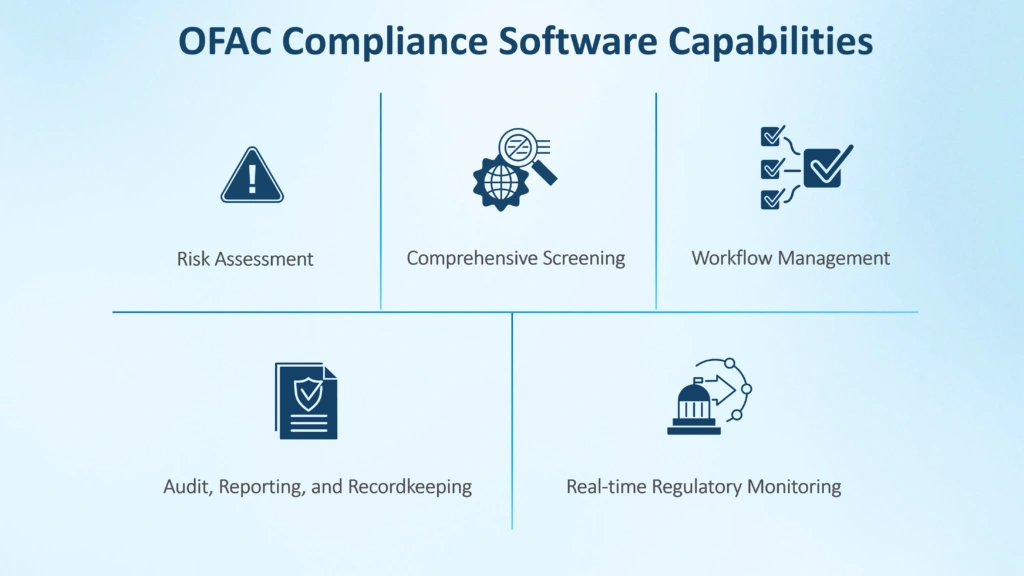The complexity of economic and trade sanctions administered by the U.S. Treasury Department’s Office of Foreign Assets Control (OFAC) has grown exponentially in recent years. As a result, OFAC screening—matching names of individuals and entities against the OFAC Specially Designated Nationals (SDN) list and other sanctions lists—has never been more important for businesses operating across the global supply chain.
While the risks of failing to identify true matches are obvious—regulatory penalties, reputational damage, and even criminal liability—false positives can be just as disruptive. When legitimate customers or transactions are wrongly flagged, it doesn’t just clog your compliance queue. It delays business, frustrates stakeholders, and exposes your company to regulatory scrutiny if those errors pile up. In high-volume environments, these misfires aren’t rare—they’re routine, and costly.
So “How do I reduce false positives in OFAC screening?” The answer lies in accuracy. That means artificial intelligence (AI)-powered denied party screening tools, advanced fuzzy-matching algorithms, real-time sanctions list updates, and risk-based filters that adapt to your business model. Without them, you’re either over-screening and slowing down your operations or under-screening and opening the door to sanctions exposure.
In this article, we explore how the right OFAC compliance software helps you strike the right balance between risk sensitivity and operational efficiency—empowering your organization to identify real threats, reduce false positives, and stay audit-ready. We’ll discuss the most impactful features, leading technologies, and best practices to elevate your trade compliance strategy.
Key Takeaways
- OFAC screening is critical to avoiding regulatory violations in international trade, but false positives can cripple operational efficiency and increase compliance risk.
- The impact of false positives in OFAC screening includes delays, higher costs, penalties, loss of productivity, and reputational harm—making automation and precision non-negotiable.
- Modern OFAC compliance software with AI-driven tools and robust matching algorithms drastically reduces false alerts while preserving security.
- Data enrichment, real-time syncing with the OFAC SDN list, and audit trail integration are essential features of any effective denied party screening tool.
- Advanced OFAC screening solutions from Descartes help organizations cut false positives while ensuring seamless, risk-based trade compliance.
The Real Cost of False Positives in OFAC Screening
False positives in OFAC screening are more than just minor inconveniences; they represent significant business costs. They quietly and overtly drive-up expenses, drain resources, and put compliance at risk. Here are four key areas where their impact is most felt:
Operational Inefficiency
Every false positive alert requires manual investigation. This can take 5-10 minutes per entry. Multiply that across hundreds or thousands of transactions, and your compliance team quickly turns from a safeguard into a bottleneck. The result? Slower operations, delayed shipments, and lost productivity across your entire supply chain.
Regulatory and Audit Risks
The burden of false positives doesn’t stop at wasted effort; it creates blind spots. Following up on false matches diverts time and resources from investigating genuine risks. The sheer volume of alerts, which can be up to 95% in some businesses, can breed alert fatigue–a dangerous state where critical signals risk being overlooked due to desensitization. This secondary risk creates opportunities for entities on the OFAC SDN list to slip through the cracks, leaving your organization more vulnerable to penalties or damaging audit findings.
Reputational Damage
No customer or business partner wants to be mistakenly flagged as a sanctioned entity. False positives not only strain relationships, they can erode trust. Delays caused by unnecessary screening hold-ups can push partners to seek faster, more reliable alternatives.
Worse still, if your OFAC screening tools consistently return inaccurate results, your company could gain a reputation for being difficult to work with—slow, unreliable, and risk-averse in the wrong ways. In global trade, reputation travels fast. And once lost, trust is hard to win back.
Financial Burden
Resolving false positives requires time, personnel, and sometimes even outside legal or consulting support—increasing compliance costs. One study placed the annual cost of financial crime compliance at $274.1 billion in 2022, driven in part by inefficient OFAC screening systems that flood teams with low-value alerts. Hiring more staff to chase down false positives doesn’t fix the root problem. But ignoring OFAC compliance isn’t an option. Penalties scale with transaction value, starting at $1,000—even for small infractions.
Bottom line: inaccurate screening is costly, but poor compliance is costlier. Investing in smarter tools that reduce false positives is essential.

How Effective OFAC Screening Tools Reduce False Positives
Modern OFAC screening solutions are built to do more than just check names; they minimize false positives by leveraging advanced tools that drive precision and streamline compliance. Here are the must-have features of any solution built to reduce false positives without compromising compliance:
1. AI-Powered OFAC Screening
Modern OFAC screening solutions use artificial intelligence and machine learning to detect patterns in alert resolutions, for example, when a cleared entity consistently presents no escalation risk. Over time, these systems adapt, deprioritizing similar alerts and reducing repetitive manual reviews. Leading AI-driven platforms minimize false positives and enhance compliance workflows by:
- Prioritizing alerts based on their likelihood of being true matches
- Machine learning from past decisions, whether escalated or cleared, to refine future results
- Lowering duplicate reviews of the same entities and decreasing manual workload
- Customized risk scoring aligned with your organization’s unique compliance policies
- Maintaining audit-ready trails to support regulatory transparency
One global logistics firm previously had to review over 50,000 denied party screening alerts daily. After implementing a solution with similar features, that number dropped to just 20,000–25,000 alerts per day, cutting the review workload by more than half.
2. Advanced Matching Algorithms
False positives often stem from minor discrepancies—like spelling errors, language variations, or inconsistent formatting. Best-in-class OFAC screening solutions leverage sophisticated matching logic to eliminate this noise. These advanced algorithms help surface real risks while filtering out irrelevant results.
Key capabilities include:
- Fuzzy matching to detect misspellings, typos, or inconsistently formatted names
- Phonetic analysis to handle accented and sound-alike names across languages
- Transliteration logic to match names across different alphabets, character sets or writing systems
- Exact match filters to catch and validate critical hits on known high-risk or restricted terms
With these features in place, OFAC screening tools reduce false positives dramatically, freeing compliance professionals to focus on what matters: investigating and responding to real threats, fast.
3. Real-time Sanctions List Updates and Enriched Screening Data
False positives thrive in outdated or incomplete data environments. Leading OFAC compliance platforms strengthen accuracy by combining real-time monitoring with enriched, authoritative data sources and contextual analysis. Capabilities that help reduce the rate of false alerts:
- Live synchronization with the OFAC SDN List, Blocked Persons List, Consolidated Sanctions List, and other global watchlists
- Entity enrichment by cross-referencing secondary data sources, address-only screening and validation, legal entity registries etc.
- Adaptive filtering to apply the OFAC 50 Percent Rule and uncover indirect ownership risk
- Narrative rule processing to interpret contextual mentions and complex affiliations
By continuously updating and validating records, modern platforms clear up ambiguity before it reaches your compliance team—reducing false positives and protecting your business from hidden risks.

4. Risk-Based OFAC Screening
Not all transactions carry equal risk. Rigid, one-size-fits-all OFAC screening floods compliance teams with noise while potentially missing red flags that truly matter. Risk-based screening solutions enable organizations to maintain compliance effectively while adapting to their unique operational and regulatory requirements. Features of risk-based screening:
- Customized screening thresholds: Set rules based on your specific risk profile
- Transaction Value – Higher-value transactions trigger stricter scrutiny
- Country of Origin– Risk-adjusted based on jurisdictional exposure
- Industry or Product Type– Match screening rigor to sector-specific compliance vulnerabilities
- Flexible screening methods: Choose the right tool for each screening scenario by business unit, region, or customer profile including:
- Ad Hoc OFAC sanctions list search Ideal for low-volume or one-off entity checks
- Batch sanctions screening Enables the simultaneous review of multiple entities. Efficiently screen existing records during onboarding, audits, or mergers and acquisitions (M&As) due diligence
- Continuous / Dynamic rescreening: Provides real-time, ongoing screening of transactions and entities. It ensures that new risks are identified and addressed promptly
- Mobile Screening solutions optimized for teams that are on the move, ensuring trade compliance goes wherever business happens
5. Integrated OFAC Screening
High-performing OFAC screening solutions don’t operate in isolation. Seamless integration with your ERP, CRM, and trade management platforms—such as Microsoft Dynamics, NetSuite, Oracle, Salesforce, SAP and Shopify among others—ensures screening is embedded where your business operates, closing compliance gaps and reducing risk. Integrated OFAC screening reduces false matches by enabling:
- Real-Time, Context-aware Decisions: Tapping into full customer profiles, transaction histories, and shipment records enables the system to screen against the right context, reducing unnecessary matches
- Consistent Records, Fewer Duplicates: Disjointed systems often produce multiple alerts for the same entity due to name variations or typos. Integrated systems standardize data, preventing redundant reviews across teams and platforms
- Risk-Based Sanctions Screening at the Source: Screening embedded within operational workflows allows for instant cross-referencing with global watchlists and prior screening outcomes
Integrated restricted party screening improves accuracy by combining real-time business data, risk-aware automation, and centralized compliance intelligence.
6. Built-In Audit Trails and Escalation Workflow
Regulators don’t just want compliance, they want proof of how you got there. Recently, OFAC extended its recordkeeping requirement from 5 to 10 years, raising expectations for documentation, transparency, and accountability.
Effective OFAC screening software solutions offer built-in audit trails and structured escalation workflows that strengthen compliance while reducing false positives. Here’s how:
- Standardizing how alerts are reviewed and resolved: inconsistent or subjective decisions give rise to high false positive rates. Clearly defined steps prevent over-flagging and ensure appropriate triage of real risks.
- Enabling team collaboration and oversight: assign alerts to the right analyst, escalate when needed, and ensure no decision is made in isolation.
- Feeding learning loops: documented outcomes from resolved cases help machine learning systems continuously improve match accuracy.
- Centralized audit trails for faster resolution: when screening decisions and justifications are logged automatically across systems, false positives are easier to investigate and resolve.
Figure 1: Core Capabilities of OFAC Compliance Software

Leading Vendors that Help Reduce OFAC Screening False Positives
Several leading vendors offer advanced OFAC screening solutions designed to cut through the noise of false positives while maintaining strict compliance. Here’s a snapshot of standout providers and their capabilities:
Descartes Denied Party Screening
Combines Descartes Visual Compliance™, Descartes MK Denial™, and Descartes OCR Global EASE™ for Watchlist Screening into one powerful platform.
Key Highlights:
- Descartes Visual Compliance AI-Assist: Uses advanced analytics and machine learning to reduce false positives by 20–60%
- Flexible Configurable Screening: Supports batch, dynamic, and mobile screening for consistent OFAC compliance, anytime, anywhere
- Up-to-Date Sanctions List: Ensures immediate updates from global watchlists and restricted party lists
- Customizable Filters: Tailors screening sensitivity to your organization’s risk profile
- Integrated Trade Compliance: Includes licensing and export control tools for end-to-end compliance

Kharon: Comprehensive risk intelligence data for enhanced due diligence such as sanctioned ownership screening. Their specialized data is integrated into solutions like Descartes denied party screening to support compliance with narrative rules like OFAC 50, forced labor laws, and other risks in complex structures.
Dow Jones Risk & Compliance: Offers enriched global sanctions and risk data, also integrates directly into Descartes tools to enhance OFAC 50 Percent Rule compliance.
Thomson Reuters World-Check: Provides detailed profiles of politically exposed persons (PEPs), global watchlists, and adverse media to improve match accuracy
LexisNexis: Pairs real-time updates with case management and decision-making tools to streamline alert resolution and reduce review backlogs.
Optimization Strategies for OFAC Screening Programs
Choosing the right OFAC compliance software is only part of the equation. Regardless of the platform you use, these best practices help to truly reduce false positives and improve screening accuracy.
- Schedule Regular Data Cleansing: Inconsistent or outdated customer/vendor records—like misspelled names or missing IDs—often trigger unnecessary alerts. Keep internal data clean, current, and consistently formatted to reduce false matches.
- Maintain Updated Sanctions Screening Lists: Ensure your screening tool updates in real time with the OFAC SDN List, Consolidated Sanctions List, and global watchlists to avoid missing new or recently updated entities.
- Automate Low-Risk Screening: Not every alert needs human review. Use rule-based logic and AI to auto-clear low-risk or previously cleared entities. This reduces analyst fatigue and keeps focus on true positives.
- Enrich Internal Data for Accurate Verification: Better data leads to better decisions. Integrate internal and external data sources to improve entity resolution and uncover hidden risks.
- Enable Continuous Learning: Your tools and your team should evolve together. Use cleared match data to retrain algorithms and run regular staff training on emerging risks, regulatory updates, and compliance tech changes.
- Conduct Frequent Audits and Feedback Loops: Human insight is essential for fine-tuning automation. Use human review to assess borderline matches and refine alert thresholds. Ongoing audits help improve both system performance and team decision-making.
Lower False Positives and Unlock Smarter OFAC Screening with Descartes
Is your OFAC screening accurate enough for today’s threats? Manual review and legacy rule-based software are no longer equipped to handle the speed and complexity of OFAC compliance risks.
Solutions like Descartes Visual Compliance offer a smarter way forward. Powered by AI and advanced matching logic, they help you reduce manual reviews, eliminate false positives, and shift focus to high-risk alerts that matter.
Don’t let outdated OFAC screening cost you growth. See how Descartes can help your team stay compliant and competitive—request a demo.
Find out what our customers are saying about Descartes Denied Party Screening on G2 – an online third-party business software review platform. Additionally, you can read this essential buyer’s guide to denied party screening to help you select a solution that fits your needs.




